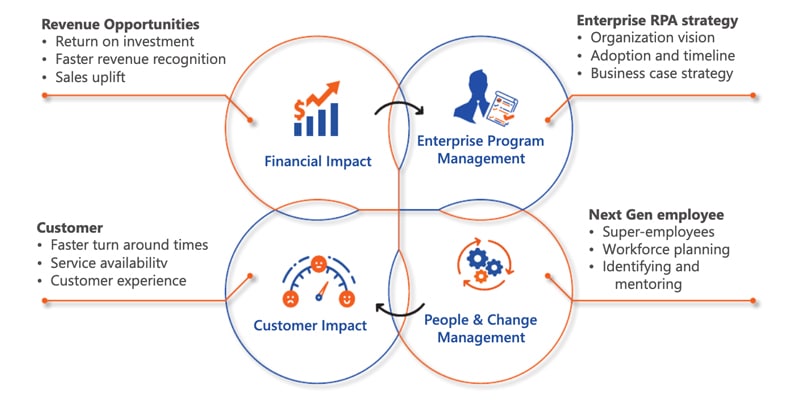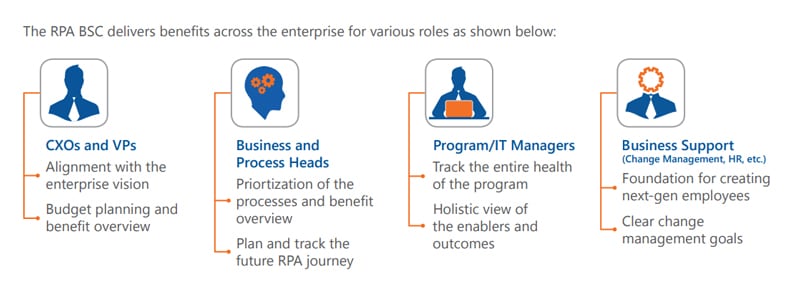Though the digital revolution began in the early twentieth century, the word automation is not entirely new. Its evolution from a mere machine to a digital transformer maybe is. Human beings invented machines centuries ago to simplify and automate certain activities to focus on other things.

Robotic Process Automation (RPA) is a leap ahead. Unlike the hardware example explained earlier, this software robot helps us simplify business processes and enables us to focus on more strategic functions. With digitization becoming an inevitable journey and changing market dynamics, enterprises across the world are increasingly adopting RPA for their business processes.
The leading analyst Gartner has estimated RPA spending to reach nearly $2B in 2021. Despite economic pressures caused by pandemic, the RPA market is expected to grow at double-digit rates through 2024.1
So, how is Robotic Process Automation different?
Robotic Process Automation (RPA) helps automate repetitive, rule-based business processes guided by business logic and structured inputs. Though this technology is relatively new, RPA has already become the most sought-after technology, adopted by enterprises across the world.
RPA technology helps businesses by processing workflow much faster and more efficiently. This further helps to free the human workforce from their mundane tasks and focus on more strategic work. This helps improve business operations, data security, and productivity.
Intelligent RPA takes automation to a whole new level. It offers the ability to learn from human intervention also helps intelligently handle processes. Artificial Intelligence and Machine Learning are helping make great strides in helping RPA mimic human decisions, but we are just getting started.
The Digital Worker
RPA offers bots, often referred to as digital employees, that work with the existing applications without making any changes to them whatsoever. RPA can help automate various processes, from employee onboarding to generating performance reports to invoice processing. RPA enables businesses to carry out these processes quickly, accurately, and by eliminating human error.
These Digital Workers are programmed to replicate manual and laborious human activities or tasks via a user interface or an Application Program Interface (API) with a software application. Once programmed, these bots conduct easy repetitive tasks as programmed with or without human intervention. They can be programmed to route exceptions to humans for inputs.
For instance, digital workers can be programmed to generate performance reports or invoices by taking all the necessary steps, including entering them into an ERP or interpreting them and taking any downstream actions. In most cases, designing such an automation flow can be done without any coding. Organizations can reassign their human workers to do value-added and strategic tasks and induct digital workers to do laborious, repetitive, and mundane tasks. This can increase their ROI, enhance employee productivity, and improve customer experience.
With Intelligent Automation, bots can be programmed to call a machine learning model to check the confidence score for executing a particular process. A threshold can be set, above which the bot can go ahead and execute the process. Below the threshold, the bot will queue this as an exception for human intervention. The interesting part is that bots can learn from human intervention, and they will not route tasks with similar exceptions to humans in the future. This constantly evolving process helps improve automation coverage for enterprises.

Benefits of RPA
Businesses can leverage RPA in multiple ways. Flexible and easy to implement, RPA can be customized to the particular needs of the organization. Enterprises leveraging RPA technology over other manual alternatives typically experience the below advantages:

Reduced cycle times
Unlike the human workforce, robots can work 24/7 without food and energy breaks, which results in reduced cycle times.

Flexibility and scalability
Once a specific process is designed to program on robots, it can be immediately implemented on as many robots as required. Similarly, robots can be easily reassigned to a different task without much hassle.

Boosts employee morale
Repetitive and rule-based processes that are least appreciated are the ones often automated. Therefore, this relieves the staff from mundane tasks and helps them focus on more rewarding and value-added operations.

Detailed data capture
Tasks performed by a BOT can be scrutinized and recorded at every step, generating an audit trail that can support further process improvement as well as regulatory compliance.

Cost reduction
RPA can help reduce operational costs by up to 80%.

Increased productivity
As the processes get simplified, RPA helps increase productivity to a large extent.

Improved data security and compliance
As most automated processes are password-protected, it helps prevent data leakage and ensure compliance.
RPA platform enables enterprises to take control of executing their transactions internally and develop more robust compliance strategies. Take financial service companies, for instance – their processes are often managed by third-party BPOs. This provides them with lesser control over processes, increasing security threats to data. With RPA, they can ensure a high level of compliance with no security breaches.
RPA tools can improve the efficiency of the following processes and the effectiveness of services without making changes to the fundamental process design.
Enterprises can also enhance their automation by injecting Intelligent RPA with cognitive techniques such as AI/ML, intelligent document processing using Vision/OCR, speech recognition, sentiment analysis, and Natural Language Processing (NLP), automating higher-order duties that previously needed human perceptual and judgment capacities.
Measuring RPA implementation performance - RPA Balanced Scorecard
Different enterprises seek different things from RPA. Their expectations from RPA depends on their business goals and objectives. For instance, an enterprise implementing RPA to improve efficiency will have a very different perspective from an enterprise that is leveraging RPA to improve compliance with regulations.
To be able to reap the right benefits of RPA, one needs to be able to measure the performance of the RPA tool they have implemented in their organization.
Here’s where you need the RPA Balanced Scorecard Framework. Balanced Score Card (BSC) helps organizations address the above-mentioned challenges using a comprehensive set of measures. It is a powerful and strategic tool that enables enterprises to track, plan, and execute RPA programs. With a focus on people and change management, BSC helps bring a 360-degree view of the cost and service enhancements. It tracks and evaluates the long-term benefits of the said RPA program. If leveraged to its optimum, RPA BSC can help enterprises plan for cost-effective, scalable implementation.
For a successful Automation (RPA) journey, an Enterprise should focus on Financial Impact, Customer Impact, Enterprise Program Management, and People and Change. The AssistEdge RPA balance scorecard™ is devised to track these aspects for a holistic view.
Expected outcomes:
- Financial impact considers the enterprise’s financial performance and the use of financial resources such as the cost-benefit or return on investment of a particular RPA program
- Customer impact considers the customer or other key stakeholders that the organization is designed to serve through optimal customer service quality response time
Enablers:
- Enterprise program management considers the performance of RPA programs by measuring quality, efficiency, governance, and ease of adoption.
- People & change management considers the performance of RPA programs by measuring learnability, adoption, technology, culture, and other capacities.

Thus, the RPA BSC covers all the strategic aspects required by an enterprise to succeed in its enterprise automation journey. It also provides measurable metrics and reports across various roles to track the progress of automation.
Benefits of measuring RPA ROI with RPA Balanced Scorecard
The benefits of BSC can be experienced across the employee spectrum ranging from beginners to adopters and leaders.

It can be tailored to suit the specific needs of an enterprise, based on
The domain/industry
Organization size
The planned size of the RPA program
The goal of the organization & expectations from the RPA program
Request a workshop to get a deeper understanding of the AssistEdge RPA balance scorecardTM
EdgeVerve AssistEdge RPA
EdgeVerve AssistEdge RPA is an award-winning RPA platform that enables end-to-end automation and assures automation success. It spans the entire gamut of automation continuum from deterministic through predictive to cognitive automation. Leveraging its AI capabilities, it helps identify processes for automation, auto-scale existing bots, and conduct sentiment analysis to drive decision making. Desktop Analytics and Mining, Attended Automation, RPA Automation, Security Management, Bot control and governance, Cognitive Automation, Machine Learning, and AI are some of its capabilities that help drive digital transformation for an enterprise.
The latest AssistEdge version AssistEdge RPA 18.x brings a host of enterprise-grade features built on strong innovation — 19+ Patent Assets around Bot orchestration, performance prediction & AI, enabling enterprises to push the Automation Frontier to 95%, and empowering enterprises to embark towards the Automation Singularity journey.
Powered by Albie- the cognitive engine, AssistEdge 18.x is delivering pervasive intelligence across the enterprise. Albie helps to identify process redesign opportunities and leverage cognitive service on tap. It enables learning from Albie Workbench to resolve and reduce errors, enables bot management, offers intelligent dashboards, and helps enrich cognitive services outcomes.
Learn how COEs play a critical role in delivering automation. Download the report
Key features of AssistEdge RPA
A highly scalable, secure, intelligent, and innovative RPA platform, AssistEdge RPA has 120+ implementations with the integration of RPA with chatbots and email bots. There are over 80 use cases to its credit where AI/ML algorithms trigger RPA bots. AssistEdge RPA enables organizations to transition between attended and unattended automation seamlessly.
With AssistEdge RPA implementation, enterprises realize the full potential of automation by offering Scalability, Security, Intelligence, and Innovation. Some of its key features are:

Computer Vision and OCR services on tap
Business users can deploy and manage cognitive services from multiple cloud-based service providers with contextual pre-and-post processing.

Contextual Intelligence
Albie, AssistEdge’s Cognitive Engine provides contextual intelligence to digital workers. It empowers human workers with insights and helps to identify process redesigning opportunities.

Business Intelligence Dashboards
AssistEdge RPA has a framework to capture business-relevant data for creating business dashboards around historical information forecasts and business impacts.

Smart Resource Management
Enterprises can now get predictive alerts on bot performance and SLA failures with the ability to scale dynamically for handling volume variations.

Expanded Automaton Footprint
Covers Citrix farms and VDI environments. The outer bots multilingual support now covers languages like Japanese, Spanish, and French.

Enterprise-grade security with access modes
Prevents unauthorized access, is GDPR ready, and is integrated with CyberArk Credential Vault, SAML and OpenID based authentication.
Conclusion
RPA is not a mere destination but a part of an entire digital transformation journey. Enterprise robotic process automation has the potential to transform the way businesses function globally. Additionally, the evolution of ML and NLP has further accelerated enterprises’ journey towards complete digital transformation. These technological advancements have prompted businesses to take on new challenges to cope with changing market dynamics and consumer demands.
Leveraging the best RPA tools and choosing the right RPA software vendors have helped enterprises gain a competitive edge and thrive even in unprecedented times such as COVID-19. Thus, RPA no longer remains just an automation tool that helps simplify processes or repetitive tasks. With cognitive RPA and its convergence with new emerging technologies, it is a step towards an efficient and intelligent future.
Request A Meeting

Thank you for your interest!
Our team will get back to you soon.













